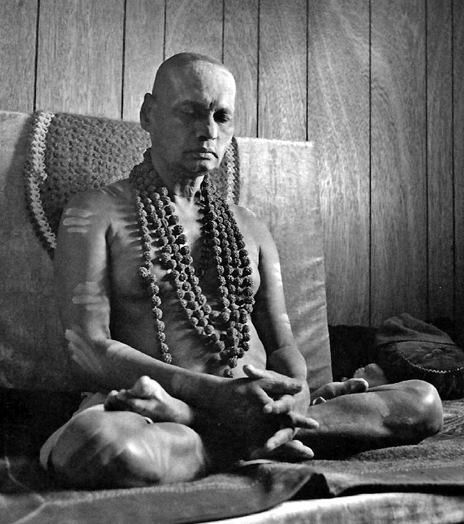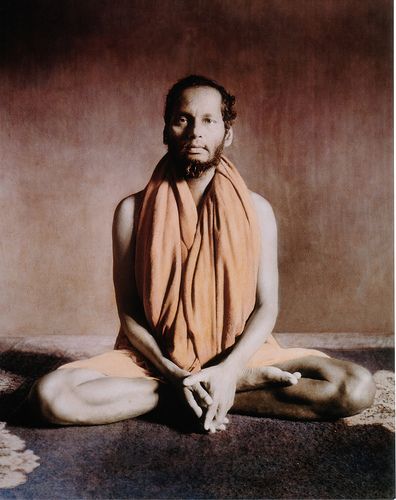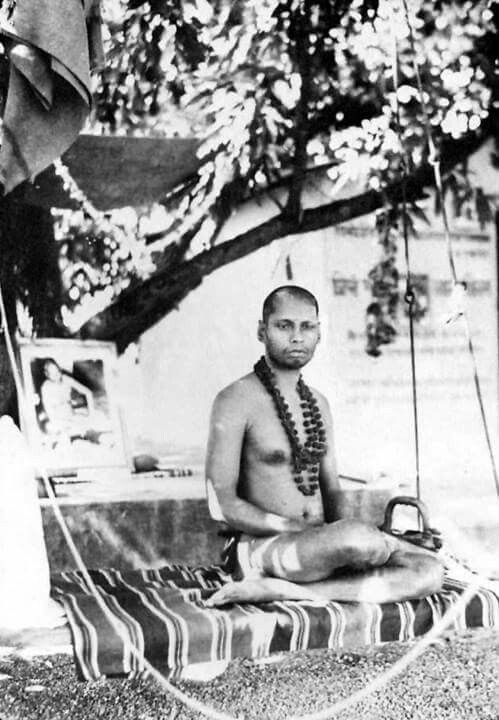Swami Muktananda was a disciple of Bhagavan Nityananda of Ganeshpuri. Bhagavan Nityananda gave him the title of ‘Paramahansa‘ means having attained enlightenment, or the supreme state of moksha.
The term ‘Paramahansa’ comes from the Sanskrit roots ‘Parama’, meaning “Supreme” or “Transcendent,” and ‘Hansa’, meaning “Swan”. It is typically translated to mean “Supreme Swan.” Someone with this title is awakened in all realms – both of matter and of spirit – and embodies the Divine. Other Siddha saints with this title you might know like Sri Ramakrishna Paramahansa, Paramahansa Swami Yogananda.

Swami Muktananda was a living Siddha Guru and the founder of Siddha Yoga Path. He wrote several books on the subjects of Kundalini Shakti, Vedanta, and Kashmir Shaivism, including a spiritual autobiography entitled The Play of Consciousness (चित्तशक्ति विलास). He is often referred to as Swami Muktananda, or Baba Muktananda, or in a familiar way just Baba.
He established Gurudev Siddha Peeth in Ganeshpuri, Maharashtra, India which also consists of a beautiful Bhagavan Nityananda Temple. He also established SYDA Foundation in the United States of America to administer the Global work of Siddha Yoga meditation. He established more than 600 meditation centers and a number of ashrams around the world.
Swami Muktananda Spiritual Journey
Swami Muktananda was born on 16th May 1908 near Mangalore, Karnataka in a wealthy family. His childhood name was Krishna Rai. After his encounter with Bhagavan Nityananda at the age of 15, Krishna left his home and began his life as a sadhu and wandered across India on foot with unending deep thirst of spiritual fulfilment.

He describes his experience of meeting Bhagavan Nityananda in his autobiography “The Play of Consciousness”:
I met my Guru, Bhagavan Nityananda, when I was very young. I was almost sixteen and still in school. Gurudev loved children, so whenever he came to our school all of us would leave our classes and follow him. The moment we followed him, he would start running and shouting. We would run after him, and then he would climb a tree and sit on a branch. We would just stay there under the tree. He was a great runner. He had great speed. He was a great walker too, he walked very fast. He walked in a strange way, in the state of an Avadhut (One in a state of constant mergence in the Divine).
Whenever he came to school the teachers would be very upset, but the children would follow him anyway. he would go into a candy store, reach into the containers, throw candy to the children, and then take off again. Still the shopkeepers never complained, because whenever he gave away candy, their sales went up. I had this feeling I wanted to be like him, that such a thing would be better than anything else.
During his wandering, he studied under Siddharudha Swami in Hubli, where he learned Sanskrit, Vedanta, and all branches of Yoga. He received his sannyasa initiation (Diksha) in the Sarasvati order of the Dashanami Sampradaya and got the name of Swami Muktananda. After Siddharudha Swami took Mahasamadhi, Swami Muktananda left to study with a Siddharudha Swami’s disciple called Muppinarya Swami at his Sri Airani Holematt in Ranebennur Haveri District. After that, Swami Muktananda began wandering across India on foot. During this time, he studied and learnt from different Saints and Siddha Gurus.

He says “I didn’t spare any of the holy places in India. I didn’t spare any of the great temples. I didn’t spare any of the great beings. I searched intensely for God in caves, mountains, and forests. I do not remember in exactly how many temples I sought Him or in how many shrines I meditated on Him to no avail. I prayed in so many different temples, but only hours slipped by and I was still without peace.”
“Then I set out in search of a guide. I wandered all by myself, pondering the mysteries of life. In the course of these wanderings, I ran into an unusual, naked saint named Zipruanna. He was very great. Although he appeared to be a fool to worldly-minded folk, he was omniscient. He seemed a naked mendicant only to those who were spiritually naked, being without knowledge. However he was the owner of a vast treasure of wisdom – a true millionaire. I loved him at first sight. We became friends. What a combination! One was a naked fakir while the other was a well dressed, modern renunciant. He said, “O you crazy one, God is within! Why do you seek him outside?”
I said, “Instruct me.”
“That is not for me to do so.” he replied. “Go back to Ganeshpuri and stay there. Your treasure lies there. Go and claim it.””
Little did he know, that his search for spiritual fulfilment will end in Ganeshpuri
On 15 August, 1947, Swami Muktananda went to Ganeshpuri to receive the darshan of Bhagavan Nityananda. This was such an auspicious day for him, which changed everything. He received Shaktipat Diskha from Bhagavan Nityananda.
He says “Bhagavan Nityananda stood facing me directly. He looked into my eyes again. Watching carefully, I saw a ray of light entering me from his pupils. It felt hot like burning fever. Its light was dazzling, like that of a high-powered bulb. As that ray emanating from Bhagavan Nityananda’s pupils penetrated mine, I was thrilled with amazement, joy, and fear. I was beholding its color and chanting ‘Guru Om’. It was a full unbroken beam of divine radiance. Its color kept changing from molten gold to saffron to a shade deeper than the blue of a shining star. I stood utterly transfixed.
He sat down and said in his aphoristic fashion, “All mantras… one. Each… from Om. Om Namah Shivaya Om… should think, Shivo’ham, I am Shiva… Shiva-Shiva…Shivo’ham…should be internal repetition. Internal…superior to external.” From “The Play of Consciousness” by Swami Muktananda.
For almost a decade thereafter, Swami Muktananda lived and did his meditation Sadhana in a small hut in Yeola.

He pens down significance of Guru and his entire spiritual journey of rigorous Sadhana in his autobiography “The Play of Consciousness”
After 9 years of Sadhana, Bhagavan Nityananda proclaimed enlightenment of Swami Muktananda, when he was seen dancing with joy and singing “Muktananda Paramahansa….Muktananda Paramahansa”
Bhagavan Nityananda predicted Swami Muktananda’s spiritual accomplishment and influence would have a far reaching; indicating his future world tours to initiate spiritual seekers around the world.
World Tours By Swami Muktananda
In 1970s, on divine direction from his Beloved Guru Bhagavan Nityananda brought the traditions of Siddha lineage to the West. He did 3 world tours covering most of the countries around the world and giving Shaktipat Initiations to thousands of spiritual seekers through Shaktipat Meditation Intensive Retreats. Baba used to speak in Hindi and his disciple, Malti (later on initiated as Swami Chidvilasanda) used to translate it into English. His communication was beyond language and culture. Spiritual seekers would experience his blissful energy and were enchanted by his warmth, his mischievous humor, and the joyful spontaneity that informed his every gesture.

First tour he did was in 1970, covering United States of America, Europe, Australia. Post that, forenigners started visiting the Gurudeva Siddha Peeth, Ashram in Ganeshpuri, India.
Second world tour happened from 1974 to 1976. It started from United States again. His caravan swept through the US via Route 66, conducting Intensive retreats in New Mexico, Colorado, Utah, Oklahoma, Michigan, and New York. Siddha Yoga Dham Associates (SYDA) was formed, and meditation centers and ashrams were founded in Oakland and Los Angeles, California; South Fallsburg, New York; Ann Arbor, Michigan; Melbourne and Sydney, Australia; and London, England; among other places. Swami Muktananda stayed in the West for 2 years and returned back to India in 1976 on a Jumbo jet with 400 devotees.
Then during the third world tour 1978 to 1981, Swami Muktananda’s teaching penetrated the mainstream of the prevailing Western culture. Programs such as the Prison Project and large conferences for psychologists, actors, and creative artists demonstrated the practical and transformational benefits of meditation and the exploration of consciousness.
Swami Muktananda and Baba Ram Dass
Swami Muktananda and Baba Ram Dass were very dear to each other. Many believe that it was Baba Ram Dass who introduced Swami Muktananda to the West. In one his interviews, he mentions how he met Swami Muktananda in 1970, in a retreat in upstate New York.
In one of his writings, Baba Ram Dass shares his experience of a lecture tour in Melbourne with Swami Muktananda in 1970.

In one his interviews, Krishna Das also mentioned about his experience of travelling with Baba Ram Dass and Swami Muktananda for a pilgrimage. He explained how through the Grace of his Guru Neem Karoli Baba, they were saved from an accident where their car was almost going fall into a water body.
Swami Muktananda Mahasamadhi
In May 1982, he appointed two successors, Swami Chidvilasananda and her brother, Swami Nityananda.
On 2nd October 1982, Swami Muktananda took Mahasamadhi in Gurudeva Siddha Peeth Ashram in Ganeshpuri. A shrine temple was also built at the place where he took Mahasamadhi known as ‘Samadhi Mandir’
Three years later in 1985, Swami Nityananda resigned from the Guru’s role. Swami Chidvilasananda, who is affectionately also called as Gurumayi, became the sole head of the Siddha Yoga lineage thereafter.
Swami Muktananda’s Main Meditation Teaching
“Meditate on your Self, Worship your Self, Kneel to your Self, Honor your Self, God dwells within you as you.”
Swami Muktananda always emphasised on the importance of meditating on self and finding the God within, rather than searching outside. It is about realising the true self within and removing the veil of ignorance.


